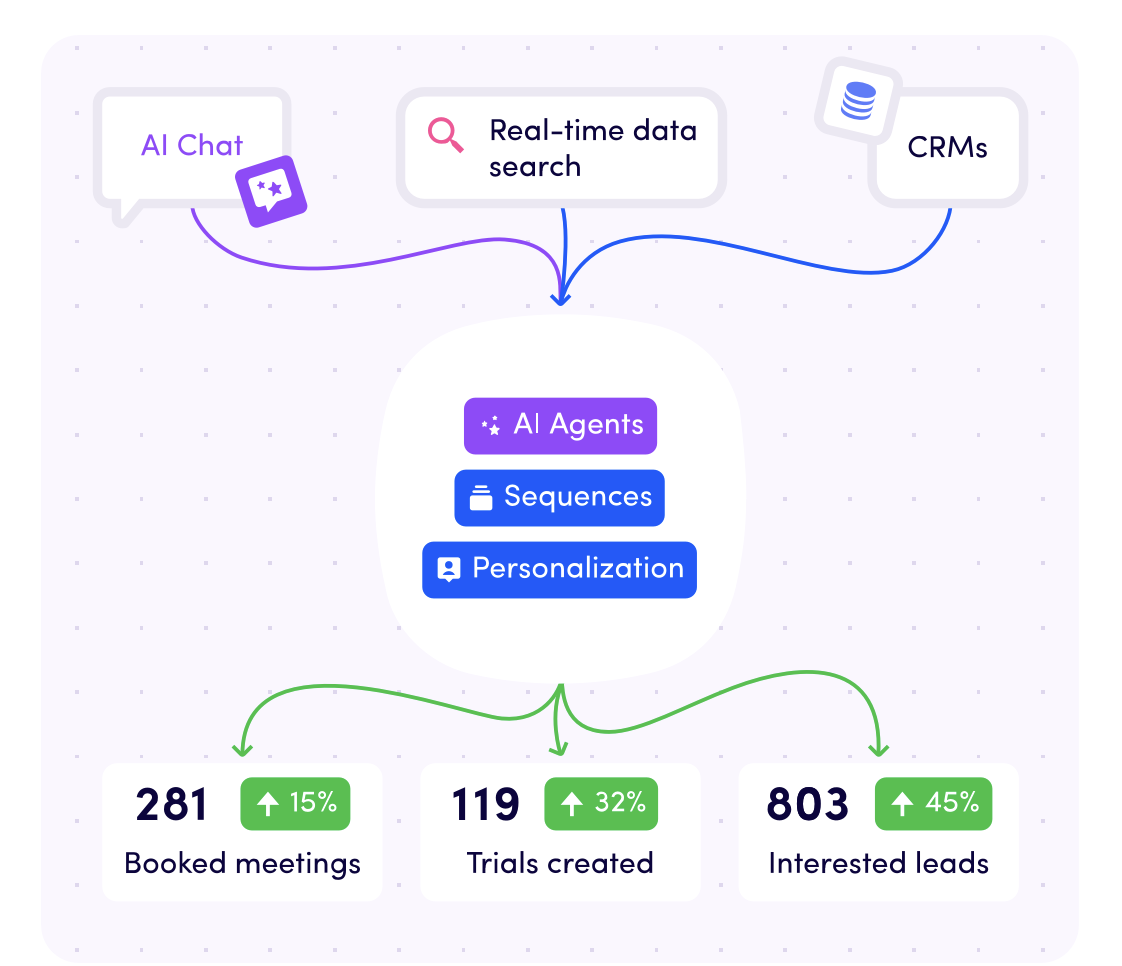In the last couple of decades, digital communication became the primary method of contact between people.
Technology has provided a constant channel of communication between people and businesses.
These advances have transformed the way companies interact with their audiences and vice versa.
Trends represent these sudden shifts in dynamics and that’s what we’ll be exploring in this article.
In detail, this is what you'll find:
- What is Digital Communication?
- The Digital Communications trends to track
- Conclusion
- FAQs
Let's dive in!
What is Digital Communication?
Digital communication is simply the way we share information using technology, like the internet, social media, email, and mobile devices. It's pretty important these days, especially since over 4.8 billion people around the world use the internet.
Digital communication professionals are employed across various fields, from marketing to PR, and graphic design to brand strategy.
For businesses, there’s a heavy reliance on digital communication to reach and engage audiences and convert prospective customers.
This makes skilled digital communicators a must-have.
To put this demand in context and to understand the related fields, see this list of the top 10 digital communication skills employers were looking for between 2020 and 2022:
- Digital Communications
- Marketing
- Digital Marketing
- Analytics
- Search Engine Optimisation
- Public Relations
- Content Creation
- Newsletters
- Journalism
- HTML
The Digital Communication Trends You Should Be Watching
It’s hard to imagine a world where fanny packs would become the accessory choice for urban wear but shocking as it may seem, we live in such a time.
Fashion is one such genre that rides the ebbs and flows of trends and technology is no different.
Society is constantly adapting to new ways of communicating with each other and businesses explore these channels in a bid to capture their customer’s attention.
Here are the digital communication trends to keep an eye on:

Hyper-personalisation is a big buzzword in the digital communication world right now and with good cause.
For years, marketers have been building stronger customer relationships by leveraging data to create more relevant and targeted advertisements or communications.
If we think of traditional personalisation, we consider the use of a customer’s first name, their location or previous buying habits to spark engagement.
Hyper-personalisation follows this same method.
But it combines real-time data, machine learning and AI to create a richer and more complex experience that is highly targeted to that specific customer.
Hyper-personalisation allows companies to hit their customers at the right time with the right content.
Chatbots are Driving Retail Revenues

It’s reported that by 2024, chatbots will facilitate $142 billion of retail revenue.
But why?
Because customers not only need but actually demand better customer experiences and chatbots help companies achieve this.
The ability to resolve a complaint or direct a query in real-time, 24/7, with minimal delay cannot be undervalued.
Chatbots free up customer service agents to spend more time dealing with complex requests.
Simpler and more mundane ones are relegated to chatbots instead.
In addition, chatbots help to qualify a customer concern or issue before it reaches an agent.
This allows for a higher level of personalization from the agent to the customer when they eventually intercept the call.
Chatbots are like data gathering robots that enhance the customer experience speedily.
But they also give customer service agents an opportunity to upsell and cross-sell based on their individual needs.
This makes it a highly effective digital communication tool.
90% of customers expect a uniform and consistent experience across multiple channels.
For businesses this means that they need to be reachable on multiple platforms and for those separate experiences to align.
If you consider a typical customer journey map, we can think about the various points at which a customer interacts with a business.
From the initial Google search to browsing a website to forgetting about it for two weeks only to stumble upon their Instagram page or have an email pop up in their inbox.
Some customer interactions are deliberate and some are passive.
But the fact remains that companies must be available for contact in several forms.
It’s about prioritising convenience and removing barriers. Omnichannel is the digital communication approach of today.

We’re talking about augmented reality (AR) here and the unique benefits it poses for businesses.
The pandemic is a great example of how businesses were restricted from physical contact with their customers. So they had to find new ways to bring customers to their “shop”.
77% of customers claimed they would shop more if a retailer used AR.
And it’s easy to see why when you think about it.
We're all pressed for time these days, whether it’s due to work or family commitments.
This makes finding time to get out there and shop around difficult. But with AR, companies can bring products to customers.
Offering them a way to experience your business through their devices is extremely powerful.
You can provide 3D tours of properties, let them explore furniture and home decor ranges, and even use social media filters to advertise your business.
AR offers a hands-off way for customers to avoid one-on-one interactions (which can be daunting) on their terms.
It removes time and location barriers and positions your business as a tech-savvy leader in digital communication.
Leveraging VR to Strengthen Customer Experiences
If we say the words “virtual reality” you probably think of gaming or a low-budget sci-fi movie.
But you might not think of how VR can be used to enhance customer experiences.
First, let’s talk about how VR is used to impact customers indirectly through training.
Companies that train employees using VR report greater knowledge retention.
VR bypasses geographical restrictions (provided they have a compatible device for the VR) and reduces training time.
All of this leads to better-trained staff who can produce better customer experiences.
Now let’s look at how VR impacts customers directly.
VR allows companies to create immersive experiences that are fun, more memorable, uniquely tell their story and allow them to showcase products.
The metaverse is a prime example of this.
In the metaverse, you can purchase digital real estate (land) which can be used to host events, build online communities, play virtual games and give a peek into projects.
This level of immersion is incredibly powerful for building customer relationships.
Other examples of VR digital communication trends are:
- Property tours
- Providing behind-the-scenes looks at businesses
- Shopping for a new car
- Using VR’s immersive capabilities to convey charitable causes such as marine or humanitarian crises.

Livestreaming is one of the most effective forms of direct marketing.
It’s a window straight from your business into the eyes (and hearts) of your audience.
There are numerous benefits for companies using livestreaming as part of their digital communication strategy, including:
- Reaching a bigger audience for virtual events. There’s no limit on how many people can attend online.
- Rich content - add images, text, live chat and more content to increase the potency of your streams.
- Easy to use - just grab a device, open up the camera and hit record. You can edit post-video and upload them to any number of platforms.
- Customer support - live videos can be used to answer burning questions from your customers, gain feedback or encourage wider discussions around a pertinent topic.

Globally, the cloud computing market will surpass $1 trillion by 2028. Trillion.
The market owes its unprecedented boost to Covid and the resulting restrictions imposed from it.
Now more than ever businesses understand the importance of having new ways to store, collaborate, and share data.
But cloud infrastructure is about more than sharing files between colleagues.
It also supports big data analytics, machine learning, the Internet of Things (IoT), and business intelligence.
Everything around us is connected in some way online.
Cloud storage is how businesses will continue to grow with and manage these massive data demands.
Multilingual Content Marketing
-Mar-28-2023-01-51-39-9115-PM.jpg?width=750&height=480&name=Resized%20Blog%20Headers%20(1)-Mar-28-2023-01-51-39-9115-PM.jpg)
An overwhelming majority of content produced online is in English.
We’ve grown accustomed to this despite the implications it has on a business’s potential loss in its audience numbers and subsequent revenue.
You're at the mercy of online translation tools.
These are pretty good these days but even so, they can’t accurately convey the nuances of a foreign language.
This has driven the development of machine translation applications, sophisticated cutting-edge technology combined with human input to simulate authentic translations.
As machine translation grows to be more refined and widely available, we’ll see its implementation become the norm across businesses catering to global audiences, especially in education fields.
Staying on Trend
The strength of a business can be defined by how willing it is to pivot and adopt new technologies.
These are the things that will secure longevity over the coming years.
Tech has always played a role, but advances are happening at such a rapid pace that both companies and their employees need to keep up.
If you’re interested in learning the right skills to future-proof your career, check out our digital courses here*.

FAQs
Why is digital communication needed?
Digital communication is necessary because it allows you to reach the most people with the least amount of effort.
This is made possible by tools such as websites, blog posts, social media texting, chat, chatbots, live streaming, and video calling.
What is an example of digital communications?
We have many examples of Digital Communication.
1. Socials: the posts you see from your favourite shoe brand are Digital Communication.
2. The blog post you are reading right now is Digital Communication.
3. The email you received from your e-commerce for the last discount is Digital Communication
Become a Digital Communication Specialist!
Master the fundamentals of Digital Communication as you learn about:
-
Module 1 - Persuasive Communication in the Digital Age
-
Module 2 - Crafting effective content
-
Module 3 - Data-informed digital communications: Knowing and impacting your audience
Learning with Growth Tribe couldn’t be easier. All of our courses are designed to be flexible for the learner with self-paced content so you can manage your time and learning, to best suit your lifestyle.
Join a community of over 35,000 certified alumni who share a passion for growing their skills and positively impacting their careers.










-Mar-28-2023-01-51-39-9115-PM.jpg?width=750&height=480&name=Resized%20Blog%20Headers%20(1)-Mar-28-2023-01-51-39-9115-PM.jpg)












